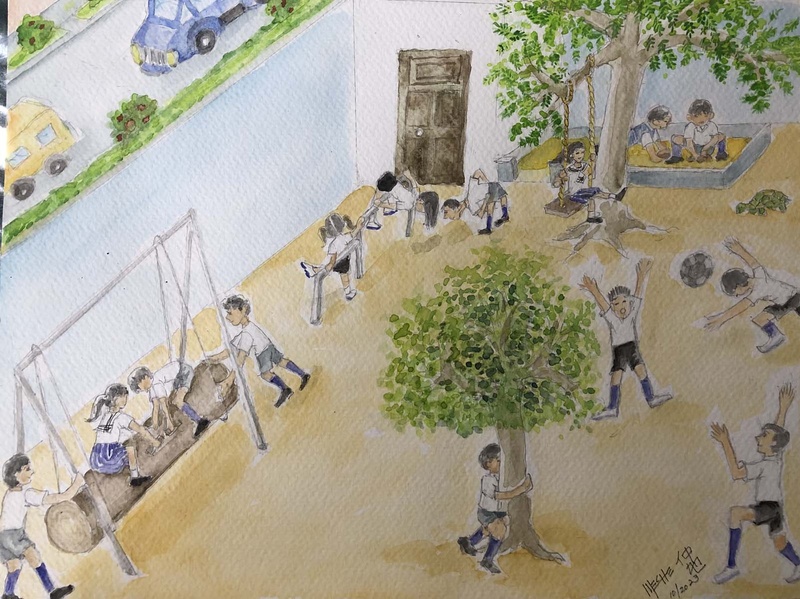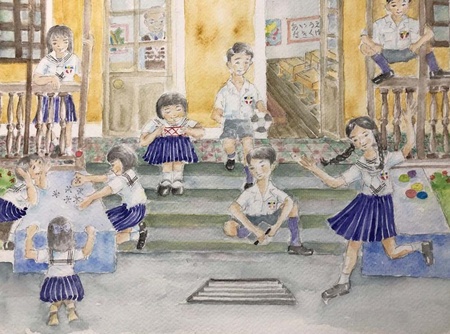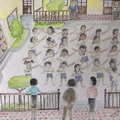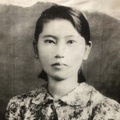At Jishuryo School, the afternoon classes were not as hard as the morning classes. Usually it was time to do Physical Education, Religion, English. An American father from the Maryknol Church came for the Religion classes. I remember that when he turned to the blackboard to write something, there was no doubt that one of the children would get into some mischief or get distracted. The father turned quickly and, without almost aiming, threw the chalk at his head.
Sometimes there were IPM (Pre-Military Instruction) classes for the boys. For this they had to put on the regular khaki uniform and they were taught to salute, march, carry a rifle and frankly I don't know what else.
Another honorable task for the fifth year students was to clean the classrooms. Every afternoon after school, the seniors took turns sweeping the floor, cleaning and straightening folders and chairs, erasing the blackboard, and brushing off specks. They climbed over the lintel of the windows and shook them vigorously. They took it seriously, but they had fun doing it. I never saw anyone renege or evade homework. The little ones watched fascinated, wanting to help.
On weekends, Victor and his assistants covered the wooden floors of the classrooms with oil (I think it was oil) which made the wood stay intact and look darker. Only the Directorate and the Teachers' Lounge were waxed.
At departure time, Víctor stood at the gate. He observed which vehicles were already waiting and shouted towards the patio:
–Bernaola...! –and all the children who were going towards the Cercado de Lima and the Rímac ran out.
–Fukai...! –and those who went to Surquillo and Miraflores left.
From time to time mobility left one of the children who, distracted by playing, did not hear that they had come to pick him up. Or sometimes the parents were late coming. They let them play in the yard, but when it got too late, he took them to Nakachi-san. There they would stay having lunch or doing their shukudai (chores) until their parents arrived.
When they lingered too long, they would be found in the dining room around a large pile of rice helping Nakachi-san and his family remove everything they needed until the rice was clean. It was fun to do it once in a while, but not every day.
At least once a week someone forgot their notebook or the book they needed to do their homework. The mother or father would come and ask Nakachi-san to please open the classroom for them. All the school keys hung on a nail on one of the walls of our small living-dining room. My father accompanied the distressed mother to the living room. The mother, who did not know what her son's folder was, opened them one by one until she recognized his things. Relieved, she took the book or notebook and bowed slightly, thanking him.
Several times a month, the school's Parent Board would meet at night, in the dining room, and ask Nakachi-san to prepare something special for them. My father would go to the Central Market and Calle Capón to buy the ingredients to prepare Japanese food for them. We helped him cut the vegetables and meat, or roll the sushi , skewer the yakitori. We helped Víctor set the table, but only he served.
That day we couldn't sleep early and we stayed until the meeting was over. The pleasure of those nights was that we didn't have to eat “warmed up.” We ate gochiso , we ate “Nakachi style” Japanese food.
The auditorium was between the first and second patios. The big brown gate was almost always closed. At that time it seemed immense and solemn to me. On one of the walls hung photos of the school's founders. We knew their names by heart: Hajime Kishii, Nakataro Arai, Motozo Nonomiya, Chuzo Fujii . In front was the piano, to one side of the stools that served as a stage. The benches with backrests were made of solid wood and very old. When the auditorium was not in use, huge black curtains covered its large windows. Walking in there at night was overwhelming.
At night the lights in the first patio lit up when the players from the Santa Beatriz club came to practice volleyball. My sister Meche and I would sit on the stone steps in the patio watching them play. This later led me to join the volleyball team during high school at María Alvarado School.
When there was light in the patio, the auditorium was also illuminated and I could practice the piano in peace. The other nights, without light, the large auditorium with black curtains covering its large windows, full of large empty benches, with an immense silence that seemed to attract those ghosts hidden in the back of the storage room, made it almost impossible to practice. the piano with tenacity and without fear. If I ever had the talent to play the piano, without a doubt, it was taken away from me by not being able to overcome the fear of the dark atmosphere of the large auditorium.
The auditorium was also used for the students' annual medical check-ups. We waited outside and entered one by one, somewhat fearful. I remember one year when they couldn't get my sister Meche in for her checkup or to receive her vaccine.
The large gates were opened for the exhibition of the painting competition and the crafts made by the students and, in July, for the Gakugeikai (Arts Festival). Each teacher prepared his students in Japanese and Peruvian dances, singing, recitation, and plays. And the mothers worked hard preparing the costumes and costumes. Everyone came to see their children act or “not act”, but happy. This and the Sports Festival were the biggest celebrations at the school, besides the First Communion and the Closing of the Year.
Many weeks before the Sports Festival we were already rehearsing. The festival was traditionally held every year in October. We were divided into Aka-gumi (red team with red hachimaki ) and Shiro-gumi (white team with white hachimaki ). Each team rehearsed throwing the balls in the basketball hoop, pulling and pulling the rope, running on three feet, running while jumping into a sack, long jump, high jump... We all hoped to win the prizes and leave. happy full of notebooks, handkerchiefs, glasses...
In October the second patio looked different. Victor and his assistants had well compacted the dirt in the yard and had marked with white chalk all the boxes and circles necessary for each race, game or dance. Red and white bunting hung above the entire yard. Awnings had been placed over the chairs, specially arranged for the guests of honor and the teachers. Parents and relatives watched the games and cheered on their children while standing on the long sidewalk on the left side of the yard. The rooms on that side and in the first patio were opened to store things and change clothes for the children who participated. We sat on the floor, or on the wooden horse, with our gym uniforms and our red or white headbands or hats, depending on the team we belonged to, shouting and encouraging our teammates.
On April 29, on the birthday of the Emperor of Japan, the Undokay (Sports Festival) of the entire Japanese Colony was celebrated. Not only the schools participated, but all the various clubs and prefectural groups in the colony. For this occasion, the best runners from the school were selected to participate in the relay against the other schools in the Japanese colony. There was always rivalry with the La Victoria School and José Gálvez. Santa Beatriz had good runners. We won many times, but we also lost, hoping to win the next year.
Every year in the winter the school took a trip to Matucana. This was what I liked the most. After dawn preparing the “obentos”. How nice it was to be able to accommodate ourselves on the bus that took us to Chosica! At the beginning of the trip I fell asleep, but as I felt the sun and saw the blue sky, I woke up and saw the farms and the green fields passing by, the cows grazing, the arid mountains. We passed Santa Clara, Vitarte, Chaclacayo, Chosica and went up to a beautiful place in Matucana.
We arrived around lunch time. Each family or group chose their place and settled in. Past the trees there was a clearing of stones and rocks very close to the river that came down from the Sierra with its cold, crystalline waters. We took off our sneakers and socks and walked in the river, looking for stones of special shapes and colors. While we played, some parents were dozing in the shade of a tree or a rock. Others were seen busy arranging, taking care of, organizing everything.
Sadly, but tired, we returned to Lima. My parents and Victor had to accommodate everything. Fortunately, that Monday was a rest day.
How many generations of children went through school in those years. Today, older, with children and grandchildren, I am sure they still remember Jishuryo and my parents. What a great privilege it was for my parents to have seen them grow up! How much joy I have seen in my parents' eyes when someone approached them and lovingly said:
- Nakachi-san... do you remember me?
For that gesture and that smile....Thank you very much!
A sincere thank you also, on behalf of my father and mother, and the 6 children (Masae, Meche, Toshi, Kenji, Chabuca and Sumi) who were able to study at Jishuryo, changing our future in Peru.
© 2024 Graciela Nakachi Morimoto







